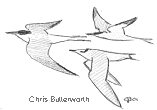April
The trickle of migrants in
March becomes a flood in April. Some significant falls of migrants can occur
given the right weather conditions, a light south easterly wind and overcast
sky, preferably after a spell of cold northerly winds. Get out early and
every shrub and tree will have a Willow Warbler or two, and the beach will
be covered with Wheatears and wagtails - if you're lucky!
Red
Rocks,
Hilbre Island and the
Point of Ayr usually produce the best spring
migrant watching. Hilbre can produce
exceptional passages of Meadow Pipits with some days having well over 1,000
passing through.
Raptors are also on their way north with the highlights being Ospreys and
Marsh Harriers. Ospreys in particular don't linger so if you see one of the
three or four which go through every year you will have been very lucky.
The tern passage gets well under way in April with Sandwich usually the
first to be seen followed by Common then Arctic. Whimbrels pass through on
their way from West Africa to Iceland, peak numbers on
Hilbre are usually in the order of thirty,
but sometimes up to eighty or so are counted.

May
Both our tern colonies start nesting in May, the Common
Terns at
Shotton, and the Little Terns at
Gronant
- more of those next month. But terns aren't the only birds breeding on the
estuary - Shelduck, Oystercatcher, Ringed Plover, Redshank, Sky Lark and
others all breed with varying degrees of success. In fact the marshes and
sand dunes of the Dee estuary are a stronghold for Sky Lark with many
hundreds of pairs present, and the marsh also supports an estimated 200 pair
of Redshank.
The spring migration continues in May albeit at a much slower pace. At the
beginning of the month we get a pulse of significantly larger Wheatears
coming through, these are birds of the Greenland race on their way from West
Africa to Greenland.
Although on many days the estuary appears to be empty of waders this is
somewhat deceptive as large numbers are passing through - Knot, Dunlin and
Sanderling in particular. They pass through quickly, sometimes in flocks
many thousand strong. Just stop, think and wonder when you see these flocks
- at this time of year it is the birds which winter the furthest south, in
West and South Africa, and breed the furthest north on the tundra of
Greenland, Canada and Siberia that we are seeing. Travelling half way around
the world in just a few weeks, how vital must the Dee and the other
estuaries of the west of Britain be to these birds as a refuelling stop
after their long journey from Africa, and the even longer trip to come
across the Atlantic or up to Siberia.
Wood Sandpipers often turn up in May, just one or two on their way to
Scandinavia, they usually drop in at Inner
Marsh Farm. In fact May can be a very good month for rarities due to
Spring 'overshoots', birds overshooting their normal breeding area. Species
seen in the past include Stone Curlew, Spoonbill, Golden Oriole, Serin and
Nightingale.

June
The tern colonies will be busy with many chicks to find food for. The Common
Tern colony at Shotton is the biggest in
Wales and goes from strength to strength. Safe from predators they nest on
rafts in a lagoon at the steel works and have increased from 301 pairs in
1994 to 555 in 2002. The much smaller Little Tern colony at
Gronant is the only one in Wales. Although
much more prone to predation this colony is also doing well, thanks to round
the clock protection by RSPB voluntary wardens. They have increased from
less than 20 pairs when the wardening scheme first started in 1975 to over
80 pairs twenty five years later.
Perhaps surprising to some June can be very good for sea watching with Manx
Shearwaters, Gannets, Guillemots and Common Scoter all to be seen in good
numbers, best during a fresh west wind. Some years we get large movements of
'Manxies' out in Liverpool Bay, several thousand strong.
Like May the estuary can seem empty of waders, and like May there are a lot
more around than you think. Many immature birds stay in their wintering
areas - species such as Black-tailed Godwit, Oystercatcher and Knot can be
present in surprisingly large numbers. Several hundred Black-tailed Godwits
over summer, many at Inner Marsh Farm.
Oystercatchers don't breed until their fourth year and 3,000 non-breeders
stay all summer. Non-breeding one year old Knots tend to stay out in the
mouth of the estuary, sometimes several thousand are seen, an odd site in
mid June!
|

